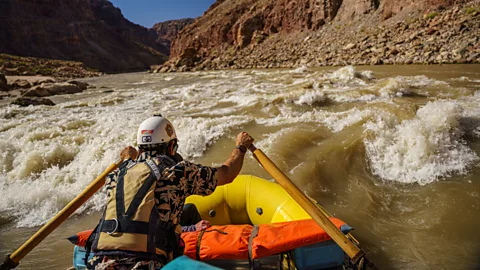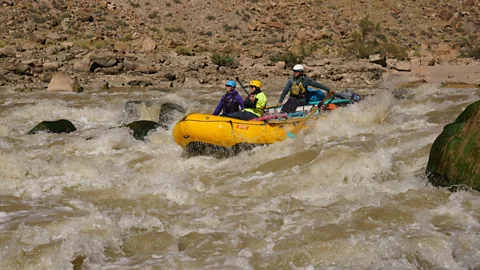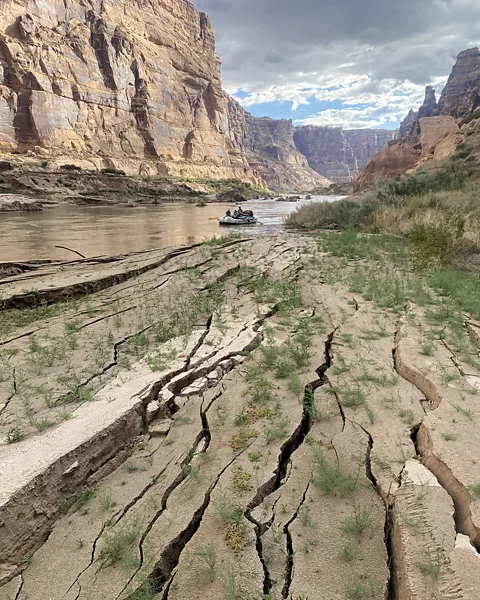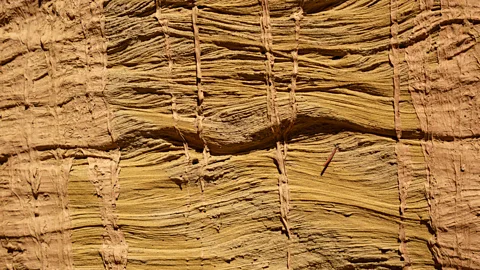A rare and wild adventure on the Colorado River
 Cassidy Randall
Cassidy RandallImagine running rapids that haven't been seen in six decades and camping on beaches that didn't exist a mere few months earlier. Welcome to Cataract Canyon.
The muddy current of the Colorado River carries our rafts through the red rock walls of Cataract Canyon in southern Utah's Canyonlands National Park. The roar of a rapid grows louder somewhere downstream. Before we reach the tumultuous churn, the rafts pull up to a small white-sand beach. Beyond, the towering walls pull back to make room for a wide drainage, called a side canyon, where Gypsum Creek trundles in to the meet the river. We'll pitch our tents here, in this remote and wild spot, and sleep under the glittering stars before continuing on tomorrow.
It sounds like a typical river trip. Until you factor in that as recently as 10 years ago, all of this was 60ft underneath the still water of Lake Powell, the huge reservoir created when the doors of Glen Canyon Dam closed in 1963 to store water for the dry and quickly growing Western states. The reservoir flooded 186 miles of the Colorado River and scores of its side canyons, and buried all of it in thick layers of sediment that dropped from the river as the current slowed on its way into Powell.
But in the last decade, Powell's level has dropped steeply – a result of overuse by the 40 million people who rely on the Colorado River for water, as well as less precipitation making its way down the watershed as the climate changes.
But there's a silver lining to those gloomy circumstances: as the reservoir recedes, the Colorado has room to flow freely again, carving through the giant dam-deposited sediment plug and restoring itself, mile by mile.
 Travis Custer
Travis CusterThis beach only came into existence earlier this year. The spot where we set up our kitchen was formerly the subsurface centre of a calm bay two football fields across. Before 2023, the rapid downstream – one in a succession of fierce torrents that made Cataract Canyon one of the most fearsome whitewater stretches in the country – hadn't been seen in my lifetime. In all, 10 of Cataract's historic rapids have re-emerged, and more are likely on their way.
SLOWCOMOTION
Slowcomotion is a BBC Travel series that celebrates slow, self-propelled travel and invites readers to get outside and reconnect with the world in a safe and sustainable way.
I'm on a raft trip with the Returning Rapids Project that's documenting the changes happening here as the river restores itself. Two of the Project's founders, Mike DeHoff and Pete Lefebvre, were river guides back when the reservoir was full; Lefebvre still guides trips down this stretch. Both say that rafting Cataract at this unique point in history is an experience both precious and exceedingly rare: the opportunity to witness the return of an entire landscape on a large scale. A canyon nearly as beautiful as the Grand Canyon just 31 miles away, cultural and historical sites, some of the most storied whitewater on the biggest river in the American West – it's all emerging for the first time since humans flooded it two generations ago.
Things are changing so fast here that each trip down Cataract today is an expedition of re-discovery of what was lost. It's a journey through the scene of leftover human impact on a vast scale and an illustration in real time of the power of nature to recover from that impact.
Early boating expeditions viewed Cataract's 41 miles of river punctuated with more than 50 fierce rapids with trepidation. "A lot of the historic photos we find show wooden boats that are pinned or flipped or damaged," said Meg Flynn, a librarian and co-founder of Returning Rapids who focuses on archival documentation of the river. "That earned Cataract Canyon the nickname 'Graveyard of the Colorado'."
 Travis Custer
Travis CusterWhen John Wesley Powell, leader of an early expedition to map the river, ran this stretch in 1869, he and his men carried their boats and gear "around nearly every rapid, which he deemed no ordinary rapids, but great waterfalls, or cataracts", wrote Melissa L Sevigny in Brave the Wild River. "By 1911, the stretch had only been run successfully four times, and seven other parties had attempted it and been deemed lost."
Later, when rubber rafts were popularised, Cataract became a beloved stretch of adrenaline-pumping whitewater for adventure seekers, celebrated as some of the most challenging whitewater in the country – even more so than the Grand Canyon, some river devotees will say.
Lake Powell drowned more than half of those rapids. At the turn of this century, a guided trip down Cataract Canyon meant rafting just 14 miles of whitewater that ended abruptly after a formidable rapid called Big Drop Three. From there, guides attached motors to rafts to take guests the rest of the way on flat lake water shared with houseboats, motorboats and water skiers, every trace of the wild river vanished as if it had never existed.
The following morning, we gear up to run Gypsum Rapid. Since Big Drop Three, we've rafted several resurrected rapids, but none as big as this one. In 1938, one expedition related that in approaching Gypsum, the river simply disappeared over a horizon line like a waterfall. On the other side hid an enormous standing wave that flipped boats end over end. As recently as 2017, Gypsum was still dormant under flat water, the boulders and steep gradient that made it so savage buried under two storeys worth of mud backed up by the dam.
 Cassidy Randall
Cassidy RandallBy 2023, Gypsum had emerged to nearly its former power. As the river speeds our raft toward it, I can see the strong current exploding over a boulder the size of a small bus in the centre. My heart speeds up. But DeHoff, on the oars, expertly, and narrowly, avoids the boat-flipping feature.
We continue on, past riverbanks where willows have sprouted. I can see signs of where beavers had slid into the river, and hear songbirds – all native species that have returned as the floodwaters ebbed. We beach the rafts and hike up to a petroglyph (an ancient rock drawing) that's re-emerged in recent years. Flynn is hoping to locate another historical marker downstream that she predicts will come up for air this season or next: "a billboard", she calls it, where early expeditions carved their names on a large rock as a sort of "we survived Cataract Canyon" marker.
More like this:
• The UK's unique, circular hike where accommodation is just £20
• The Erie Canal: The manmade waterway that transformed the US
• The Pacific Crest Trail: The US West Coast's 'greatest footpath'
We stop for lunch at a side canyon called Clearwater. DeHoff and LeFebvre recall when boats could motor for 15 minutes up this canyon on the high waters of Powell. Now we hike up it on foot, along a trickling creek lined with desert flowers. As we walk, Lefebvre tells me that river guides have begun using the field notes that Returning Rapids compiles each year to document changes, point out landmarks that have emerged and bring these environmental miracles of restoration to the attention of their guests.
It's easy to think, with such lovely hallmarks of the river's recovery, that the Colorado River will turn the tables: restore itself as Lake Powell drops until all traces of the reservoir vanish.
But then there's all the mud.
 Travis Custer
Travis CusterIt becomes more prominent the further we travel downriver: half a century's worth of sediment with nowhere to go except slammed up against the dam. The current is scouring it out of the river channel, but walls of dried sediment line the banks. Near Gypsum, they're 20ft high. Past Clearwater, they're 50ft, unstable and often collapsing into the river in otherworldly avalanches. Before it dries, the mud is so unconsolidated that it can make finding a campsite on the lower reaches of Cataract a difficult and messy proposition. The mud is the reminder that the river can't fully restore itself without human intervention from the US government agencies who manage this land. As of yet, though, there's no plan for dealing with all this displaced sediment.
Zack Sam, a river guide with OARS who regularly leads trips down Cataract, calls this stretch of the Colorado below Lake Powell "more raw, more wild than the Grand Canyon". "Cataract is a very dynamic environment," he said. "You go through it one week, and it's already changing the next. No two trips are the same."
Add in the elements of the river restoring itself – mud rapids have appeared and disappeared from all the sludge moving downstream, new beaches form and old ones slump away – and "there's a sense of adventure special only to Cataract Canyon", he said.
Most experts agree that Lake Powell will never refill again in this era of climate change, and will, instead, likely continue to drop. More rapids will return. More stories from our past will re-surface. And a trip down Cataract will, for many years to come, hold so much more wonder than a typical jaunt down a desert river.
--
If you liked this story, sign up for The Essential List newsletter – a handpicked selection of features, videos and can't-miss news, delivered to your inbox twice a week.
